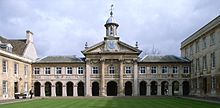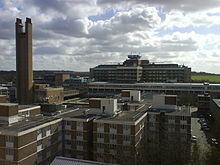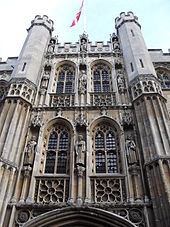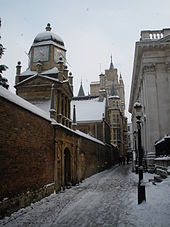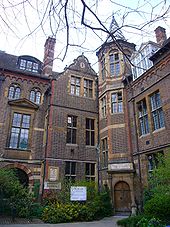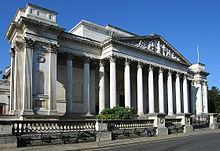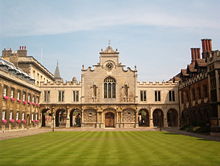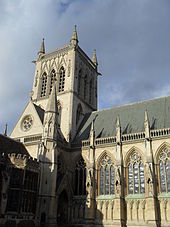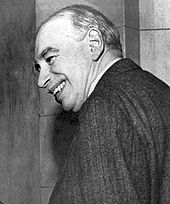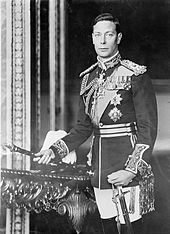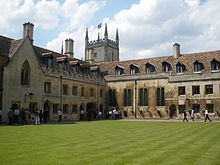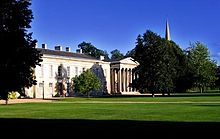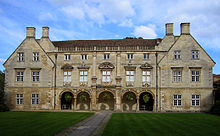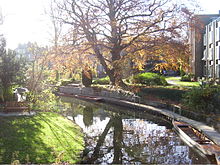
University of Cambridge
Background Information
SOS Children made this Wikipedia selection alongside other schools resources. SOS mothers each look after a a family of sponsored children.
| University of Cambridge | |
|---|---|
 Coat of Arms of the University of Cambridge |
|
| Latin: Universitas Cantabrigiensis | |
| Motto | Hinc lucem et pocula sacra (Latin) |
| Motto in English | Literal: From here, light and sacred draughts Non-literal: From this place, we gain enlightenment and precious knowledge |
| Established | c. 1209 |
| Type | Public |
| Endowment | £4.3 billion (2011, incl. colleges) |
| Chancellor | The Lord Sainsbury of Turville |
| Vice-Chancellor | Sir Leszek Borysiewicz |
| Academic staff | 5,999 |
| Admin. staff | 3,142 |
| Students | 18,448 |
| Undergraduates | 12,077 |
| Postgraduates | 6,371 |
| Location | Cambridge, England, UK |
| Colours | Cambridge Blue |
| Athletics | The Sporting Blue |
| Affiliations | Russell Group Coimbra Group EUA G5 LERU IARU |
| Website | www.cam.ac.uk |
| |
|
The University of Cambridge (informally known as Cambridge University or simply as Cambridge) is a public research university located in Cambridge, England, United Kingdom. It is the second-oldest university in the English-speaking world (after the University of Oxford), and the third- oldest surviving university in the world. In post-nominals the university's name is abbreviated as Cantab, a shortened form of Cantabrigiensis (an adjective derived from Cantabrigia, the Latinised form of Cambridge). The university is considered to be one of the most prestigious institutions of higher learning in the United Kingdom and the world.
The university grew out of an association of scholars that was formed in 1209, early records suggest, by scholars leaving Oxford after a dispute with townsfolk. The two "ancient universities" have many common features and are often jointly referred to as Oxbridge. In addition to cultural and practical associations as a historic part of British society, they have a long history of rivalry with each other. Today, Cambridge is a collegiate university with a student population in excess of 18,000. Its faculties, departments and 31 colleges occupy different locations in town including purposely-built sites and the student life thrives with numerous opportunities in the arts, sport clubs and societies.
Cambridge has performed consistently in various league tables over the years, achieving the top spot in the world according to the QS World University Rankings in both 2010 and 2011; in 2012, the same editors ranked Cambridge second. In 2011, Cambridge ranked third, after Harvard and MIT, in the Times Higher Education World Reputation Rankings. Graduates of the university have won a total of 65 Nobel Prizes, the most of any university in the world.
Cambridge is a member of the Coimbra Group, the G5, the International Alliance of Research Universities, the League of European Research Universities and the Russell Group of research-led British universities. It forms part of the 'golden triangle' of British universities.
History
The official founding of Cambridge University is traced to the enhancement, by a charter in 1231 from King Henry III of England, which awarded the ius non trahi extra (a right to discipline its own members) plus some exemption from taxes, and a bull in 1233 from Pope Gregory IX that gave graduates from Cambridge the right to teach "everywhere in Christendom".
After Cambridge was described as a studium generale in a letter by Pope Nicholas IV in 1290, and confirmed as such in a bull by Pope John XXII in 1318, it became common for researchers from other European medieval universities to come and visit Cambridge to study or to give lecture courses.
Foundation of the colleges

The colleges at the University of Cambridge were originally an incidental feature of the system. No college is as old as the university itself. The colleges were endowed fellowships of scholars. There were also institutions without endowments, called hostels. The hostels were gradually absorbed by the colleges over the centuries, but they have left some indicators of their time, such as the name of Garret Hostel Lane.
Hugh Balsham, Bishop of Ely, founded Peterhouse in 1284, Cambridge's first college. Many colleges were founded during the fourteenth and fifteenth centuries, but colleges continued to be established throughout the centuries to modern times, although there was a gap of 204 years between the founding of Sidney Sussex in 1596 and Downing in 1800. The most recently established college is Robinson, built in the late 1970s. However, Homerton College only achieved full university college status in March 2010, making it the newest full college (it was previously an "Approved Society" affiliated with the university).
In medieval times, many colleges were founded so that their members would pray for the souls of the founders, and were often associated with chapels or abbeys. A change in the colleges' focus occurred in 1536 with the Dissolution of the Monasteries. King Henry VIII ordered the university to disband its Faculty of Canon Law and to stop teaching " scholastic philosophy". In response, colleges changed their curricula away from canon law, and towards the classics, the Bible, and mathematics.
As Cambridge moved away from Canon Law, it also moved away from Catholicism. As early as the 1520s, Lutheranism and what was to become more broadly known as the Protestant Reformation were making their presence felt in the intellectual discourse of the university. Among those involved was Thomas Cranmer, later to become Archbishop of Canterbury. As it became convenient to Henry VIII in the 1530s, the King looked to Cranmer and others (within and without Cambridge) to craft a new path that was different from Catholicism yet also different from what Martin Luther had in mind.
Nearly a century later, the university was at the centre of a Protestant schism. Many nobles, intellectuals and even common folk saw the ways of the Church of England as being too similar to the Catholic Church and that it was used by the crown to usurp the rightful powers of the counties. East Anglia was the centre of what became the Puritan movement and at Cambridge, it was particularly strong at Emmanuel, St Catharine's Hall, Sidney Sussex and Christ's College. They produced many "non-conformist" graduates who greatly influenced, by social position or pulpit, the approximately 20,000 Puritans who left for New England and especially the Massachusetts Bay Colony during the Great Migration decade of the 1630s. Oliver Cromwell, Parliamentary commander during the English Civil War and head of the English Commonwealth (1649–1660), attended Sidney Sussex.
Mathematics and Mathematical Physics

From the time of Isaac Newton in the later 17th century until the mid-19th century, the university maintained a strong emphasis on applied mathematics, particularly mathematical physics. Study of this subject was compulsory for graduation, and students were required to take an exam for the Bachelor of Arts degree, the main first degree at Cambridge in both arts and science subjects. This exam is known as a Tripos. Students awarded first-class honours after completing the mathematics Tripos were named wranglers. The Cambridge Mathematical Tripos was competitive and helped produce some of the most famous names in British science, including James Clerk Maxwell, Lord Kelvin and Lord Rayleigh. However, some famous students, such as G. H. Hardy, disliked the system, feeling that people were too interested in accumulating marks in exams and not interested in the subject itself.
Pure mathematics at Cambridge in the 19th century had great achievements but also missed out on substantial developments in French and German mathematics. Pure mathematical research at Cambridge finally reached the highest international standard in the early 20th century, thanks above all to G. H. Hardy and his collaborator, J. E. Littlewood. In geometry, W. V. D. Hodge brought Cambridge into the international mainstream in the 1930s.
Although diversified in its research and teaching interests, Cambridge today maintains its strength in mathematics. Cambridge alumni have won six Fields Medals and one Abel Prize for mathematics, while individuals representing Cambridge have won four Fields Medals. The University also runs a Master of Advanced Study course in mathematics.
Modern period

After the Cambridge University Act formalized the organizational structure of the University, the study of many new subjects was introduced, such as theology, history and modern languages. Resources necessary for new courses in the arts, architecture and archeology were generously donated by Richard Fitzwilliam of Trinity College. Between 1896 and 1902, Downing College sold part of its land to build the Downing Site, comprising new scientific laboratories for anatomy, genetics and Earth sciences. During the same period, the New Museums Site was erected, including the Cavendish Laboratory, which has since moved to the West Cambridge Site, and other departments for chemistry and medicine.
Teaching was heavily disrupted during the First World War in which more than 14,000 members of the University took part and 2,470 died. As a consequence, new State funding started to flow to the institution. Following the Second World War, the University saw a rapid expansion of student numbers and available places; this was partly due to the success and popularity gained by many Cambridge scientists.
Contributions to the advancement of science
Many of history's most important scientific discoveries were made by Cambridge alumni. These include:
- Articulation of the scientific method, by Francis Bacon
- Discovery of the laws of motion and the calculus, by Sir Isaac Newton
- Discovery of Hydrogen, by Henry Cavendish
- Fundamental contributions to thermodynamics, by Lord Kelvin
- Formulation of the laws of electromagnetism, by James Clerk Maxwell
- Discovery of the electron, by J. J. Thomson
- Discovery of the atomic nucleus, by Ernest Rutherford
- Discovery of evolution by natural selection, by Charles Darwin
- Fundamental contributions to the Modern Synthesis of Darwinian evolution and Mendelian genetics, by Ronald Fisher
- Formulation of the theory of computation, by Alan Turing
- Discovery of the DNA double helix by Francis Crick and James D. Watson
- Fundamental contributions to quantum mechanics, by Paul Dirac
- Fundamental contributions to cosmology, by Stephen Hawking
- Fundamental contributions to string theory, by Michael Green
Women's education
Initially, only male students were enrolled into the university. The first colleges for women were Girton College (founded by Emily Davies) in 1869 and Newnham College in 1872 (founded by Anne Clough and Henry Sidgwick), followed by Hughes Hall in 1885 (founded by Elizabeth Phillips Hughes as the Cambridge Teaching College for Women), New Hall (later renamed Murray Edwards College) in 1954, and Lucy Cavendish College in 1965. The first women students were examined in 1882 but attempts to make women full members of the university did not succeed until 1948. Women were allowed to study courses, sit examinations, and have their results recorded from 1881; for a brief period after the turn of the twentieth century, this allowed the " steamboat ladies" to receive ad eundem degrees from the University of Dublin.
From 1921 women were awarded diplomas which "conferred the Title of the Degree of Bachelor of Arts". As they were not "admitted to the Degree of Bachelor of Arts" they were excluded from the governing of the university. Since students must belong to a college, and since established colleges remained closed to women, women found admissions restricted to colleges established only for women. Starting with Churchill, Clare and King's Colleges, all of the men's colleges began to admit women between 1972 and 1988. One women's college, Girton, also began to admit male students from 1979, but the other women's colleges did not follow suit. As a result of St Hilda's College, Oxford, ending its ban on male students in 2008, Cambridge is now the only remaining United Kingdom University with colleges which refuse to admit males, with three such institutions (Newnham, Murray Edwards and Lucy Cavendish). In the academic year 2004–5, the university's student gender ratio, including post-graduates, was male 52%: female 48%.
Myths, legends and traditions
As an institution with such a long history, the University has developed a large number of myths and legends. The vast majority of these are untrue, but have been propagated nonetheless by generations of students and tour guides.
A discontinued tradition is that of the wooden spoon, the 'prize' awarded to the student with the lowest passing grade in the final examinations of the Mathematical Tripos. The last of these spoons was awarded in 1909 to Cuthbert Lempriere Holthouse, an oarsman of the Lady Margaret Boat Club of St John's College. It was over one metre in length and had an oar blade for a handle. It can now be seen outside the Senior Combination Room of St John's. Since 1909, results were published alphabetically within class rather than score order. This made it harder to ascertain who the winner of the spoon was (unless there was only one person in the third class), and so the practice was abandoned.
Each Christmas Eve, BBC radio and television broadcasts The Festival of Nine Lessons and Carols by the Choir of King's College, Cambridge. The radio broadcast has been a national Christmas tradition since it was first transmitted in 1928 (though the festival has existed since 1918). The radio broadcast is carried worldwide by the BBC World Service and is also syndicated to hundreds of radio stations in the USA. The first television broadcast of the festival was in 1954.
Location
The university occupies a central location within the city of Cambridge, with the students taking up a significant proportion (nearly 20%) of the town's population and heavily distorting the age structure. Most of the older colleges are situated nearby the city centre and river Cam, along which it is traditional to punt in order to appreciate the buildings and surroundings.
Sites
The University is divided into several sites where the different departments are placed. The main ones are:
|
|
The University's School of Clinical Medicine is based in Addenbrooke's Hospital where students in medicine undergo their three-year clinical placement period after obtaining their BA degree, while the West Cambridge site is undergoing a major expansion and will host a new sports development. In addition, the Judge Business School, situated on Trumpington Street, provides management education courses since 1990 and is consistently ranked within the top 30 business schools globally by the Financial Times.
Given that the sites are in relative close proximity to each other and the area around Cambridge is reasonably flat, one of the favourite modes of transport for students is the bicycle: a fifth of the journeys in the town is made by bike, a figure enhanced by the fact that pupils are not permitted to hold car park permits.
Town and Gown
The relationship between the University and the city has not always been positive. The phrase Town and Gown is employed to differentiate inhabitants of Cambridge from students at the University, who often wear their academical dresses. There are many stories of ferocious rivalry between the two categories: in 1381, strong clashes brought about attacks and looting of university properties while locals contested the privileges granted by the government to the academic staff. Following these events, the Chancellor was given special powers allowing him to persecute the criminals and re-establish order in the city. Attempt to reconcile the two groups followed over time, and in the 16th century agreements were signed in order to improve the quality of streets and student accommodation around the city. However, this was followed by new confrontations when the plague hit Cambridge in 1630 and colleges refused to help those affected by the disease by locking their sites.
Nowadays, these conflicts have somewhat subsided and the University has become an opportunity for employment among the population, providing an increased level of wealth in the area. The enormous growth in the number of high-tech, biotech, providers of services and related firms situated near the town has been termed the Cambridge Phenomenon: the addition of 1,500 new, registered companies and as many as 40,000 jobs between 1960 and 2010 has been directly related to the presence and importance of the educational institution.
Organisation

Cambridge is a collegiate university, meaning that it is made up of self-governing and independent colleges, each with its own property and income. Most colleges bring together academics and students from a broad range of disciplines, and within each faculty, school or department within the university, academics from many different colleges will be found.
The faculties are responsible for ensuring that lectures are given, arranging seminars, performing research and determining the syllabi for teaching, overseen by the General Board. Together with the central administration headed by the Vice-Chancellor, they make up the entire Cambridge University. Facilities such as libraries are provided on all these levels: by the University (the Cambridge University Library), by the Faculties (Faculty libraries such as the Squire Law Library), and by the individual colleges (all of which maintain a multi-discipline library, generally aimed mainly at their undergraduates).
Colleges
The colleges are self-governing institutions with their own endowments and property, founded as integral parts of the university. All students and most academics are attached to a college. Their importance lies in the housing, welfare, social functions, and undergraduate teaching they provide. All faculties, departments, research centres, and laboratories belong to the university, which arranges lectures and awards degrees, but undergraduates receive their supervisions—small-group teaching sessions, often with just one student—within the colleges. Each college appoints its own teaching staff and fellows, who are also members of a university department. The colleges also decide which undergraduates to admit to the university, in accordance with university regulations.
Cambridge has 31 colleges, of which three, Murray Edwards, Newnham and Lucy Cavendish, admit women only. The other colleges are mixed, though most were originally all-male. Darwin was the first college to admit both men and women, while Churchill, Clare, and King's were the first previously all-male colleges to admit female undergraduates, in 1972. In 1988 Magdalene became the last all-male college to accept women. Clare Hall and Darwin admit only postgraduates, and Hughes Hall, Lucy Cavendish, St Edmund's and Wolfson admit only mature (i.e. 21 years or older on date of matriculation) students, encompassing both undergraduate and graduate students. All other colleges admit both undergraduate and postgraduate students with no age restrictions.
Colleges are not required to admit students in all subjects, with some colleges choosing not to offer subjects such as architecture, history of art or theology, but most offer close to the complete range. Some colleges maintain a bias towards certain subjects, for example with Churchill leaning towards the sciences and engineering, while others such as St Catharine's aim for a balanced intake. Costs to students (accommodation and food prices) vary considerably from college to college. Others maintain much more informal reputations, such as for the students of King's College to hold left-wing political views, or Robinson College and Churchill College's attempts to minimise its environmental impact.
There are also several theological colleges in Cambridge, separate from Cambridge University, including Westcott House, Westminster College and Ridley Hall Theological College, that are, to a lesser degree, affiliated to the university and are members of the Cambridge Theological Federation.
Teaching
Teaching involves a mixture of lectures, organised by the university departments, and supervisions, organised by the colleges. Science subjects also involve laboratory sessions, organised by the departments. The relative importance of these methods of teaching varies according to the needs of the subject. Supervisions are typically weekly hour-long sessions in which small groups of students (usually between one and three) meet with a member of the teaching staff or with a doctoral student. Students are normally required to complete an assignment in advance of the supervision, which they will discuss with the supervisor during the session, along with any concerns or difficulties they have had with the material presented in that week's lectures. The assignment is often an essay on a subject set by the supervisor, or a problem sheet set by the lecturer. Depending on the subject and college, students might receive between one and four supervisions per week. This pedagogical system is often cited as being unique to Cambridge and Oxford (where "supervisions" are known as " tutorials").
A tutor named William Farish developed the concept of grading students' work quantitatively at the University of Cambridge in 1792.
Schools, faculties and departments
In addition to the 31 colleges, the university is made up of over 150 departments, faculties, schools, syndicates and other institutions. Members of these are usually also members of one of the colleges and responsibility for running the entire academic programme of the university is divided amongst them.
A "School" in the University of Cambridge is a broad administrative grouping of related faculties and other units. Each has an elected supervisory body—the "Council" of the school—comprising representatives of the constituent bodies. There are six schools:
|
|
Teaching and research in Cambridge is organised by faculties. The faculties have different organisational sub-structures which partly reflect their history and partly their operational needs, which may include a number of departments and other institutions. In addition, a small number of bodies entitled 'Syndicates' have responsibilities for teaching and research, e.g. Cambridge Assessment, the University Press, and the University Library.
Academic year
The academic year is divided into three academic terms, determined by the Statutes of the University. Michaelmas Term lasts from October to December; Lent Term from January to March; and Easter Term from April to June.
Within these terms undergraduate teaching takes place within eight-week periods called Full Terms. According to the University statutes, it is a requirement that during this period all students should live within 10 miles of the Church of St Mary the Great; this is defined as Keeping term. Pupils can graduate only if they fulfill this condition for nine terms (three years) when obtaining a Bachelor of Arts or twelve terms (four years) when studying for a Master of Science, Engineering or Mathematics.
These terms are shorter than those of many other British universities. Undergraduates are also expected to prepare heavily in the three holidays (known as the Christmas, Easter and Long Vacations).
Central administration
Chancellor and Vice-Chancellor
The office of Chancellor of the University, for which there are no term limits, is mainly ceremonial and is held by David Sainsbury, Baron Sainsbury of Turville, following the retirement of the Duke of Edinburgh on his 90th birthday in June, 2011. Lord Sainsbury was nominated by the official Nomination Board to succeed him, and Abdul Arain, owner of a local grocery store, Brian Blessed and Michael Mansfield were also nominated. The election took place on 14 and 15 October 2011. David Sainsbury won the election taking 2,893 of the 5,888 votes cast, winning on the first count.
The current Vice-Chancellor is Leszek Borysiewicz. While the Chancellor's office is ceremonial, the Vice-Chancellor is the de facto principal administrative officer of the University. The university's internal governance is carried out almost entirely by its own members, with very little external representation on its governing body, the Regent House (though there is external representation on the Audit Committee, and there are four external members on the University's Council, who are the only external members of the Regent House).
Senate and the Regent House
The Senate consists of all holders of the MA degree or higher degrees. It elects the Chancellor and the High Steward, and elected two members of the House of Commons until the Cambridge University constituency was abolished in 1950. Prior to 1926, it was the University's governing body, fulfilling the functions that the Regent House fulfils today. The Regent House is the University's governing body, a direct democracy comprising all resident senior members of the University and the Colleges, together with the Chancellor, the High Steward, the Deputy High Steward, and the Commissary. The public representatives of the Regent House are the two Proctors, elected to serve for one year, on the nomination of the Colleges.
Council and the General Board
Although the University Council is the principal executive and policy-making body of the University, therefore, it must report and be accountable to the Regent House through a variety of checks and balances. It has the right of reporting to the University, and is obliged to advise the Regent House on matters of general concern to the University. It does both of these by causing notices to be published by authority in the Cambridge University Reporter, the official journal of the University. Since January 2005, the membership of the Council has included two external members, and the Regent House voted for an increase from two to four in the number of external members in March 2008, and this was approved by Her Majesty the Queen in July 2008.
The General Board of the Faculties is responsible for the academic and educational policy of the University, and is accountable to the Council for its management of these affairs.
Faculty Boards are responsible to the General Board; other Boards and Syndicates are responsible either to the General Board (if primarily for academic purposes) or to the Council. In this way, the various arms of the University are kept under the supervision of the central administration, and thus the Regent House.
Finances
Cambridge is by far the wealthiest university in the UK and in the whole of Europe, with an endowment of £4.3 billion in 2011. This is made up of around £1.6 billion tied directly to the university and £2.7 billion to the colleges. As of 2011, Oxford had an endowment valued at around £3.3 billion. The university's operating budget is well over £1 billion per year. Each college is an independent charitable institution with its own endowment, separate from that of the central university endowment. If ranked on a US university endowment table on most recent figures, Cambridge would rank fifth compared with the eight Ivy League institutions (subject to market fluctuations) and eleventh with all US universities.
Comparisons between Cambridge's endowment and those of other top US universities are, however, inaccurate because being a state-funded public university (although the status of Cambridge as a public university cannot be compared with US or European public universities as, for example, the state does not "own" the university), Cambridge receives a major portion of its income through education and research grants from the British Government. In 2006–7, it was reported that approximately one third of Cambridge's income comes from UK government funding for teaching and research, with another third coming from other research grants. Endowment income contributes around £130 million. The University also receives a significant income in annual transfers from the Cambridge University Press. Comparing the operating budgets, which include all sources of revenue, gives a more accurate account of relative financial strength. Several universities in the US, including Harvard, Stanford, UCLA, and others, have operating budgets larger than £1.25 billion, which was Cambridge's reported income in 2011.
Benefactions and fundraising
In 2000, Bill Gates of Microsoft donated US$210 million through the Bill and Melinda Gates Foundation to endow the Gates Scholarships for students from outside the UK seeking postgraduate study at Cambridge.
In 2005 the Cambridge 800th Anniversary Campaign was launched, aimed at raising £1 billion by 2012—the first US-style university fund-raising campaign in Europe. This aim was reached in the financial year 2009–2010, with raising £1.037 billion.
Collections
Libraries and museums
The university has 114 libraries. The Cambridge University Library is the central research library, which holds over 8 million volumes. It is a legal deposit library, therefore it is entitled to request a free copy of every book published in the UK and Ireland. In addition to the University Library and its dependents, every faculty has a specialised library; for example, the History Faculty's Seeley Historical Library possesses more than 100,000 books. Furthermore, every college has a library as well, partially for the purposes of undergraduate teaching, and the older colleges often possess many early books and manuscripts in a separate library. For example Trinity College's Wren Library has more than 200,000 books printed before 1800, while Corpus Christi College's Parker Library possesses one of the greatest collections of medieval manuscripts in the world, with over 600 manuscripts.
Cambridge University operates eight arts, cultural, and scientific museums, and a botanic garden:
- The Fitzwilliam Museum, is the art and antiquities museum
- The Kettle's Yard is a contemporary art gallery
- The Museum of Archaeology and Anthropology, University of Cambridge houses the University's collections of local antiquities, together with archaeological and ethnographic artifacts from around the world
- The Cambridge University Museum of Zoology
- The Museum of Classical Archaeology, Cambridge
- The Whipple Museum of the History of Science
- The Sedgwick Museum of Earth Sciences is the geology museum of the University
- The Scott Polar Research Institute comprises the Polar Museum, dedicated to the Arctic and Antarctic exploration
- The Cambridge University Botanic Garden is the botanic garden of the university, created in 1831
Academics

Research
Cambridge University has research departments and teaching faculties in most academic disciplines, and spends around £650 million in a year for research. All research and lectures are conducted by University Departments. The colleges are in charge of giving or arranging most supervisions, student accommodation, and funding most extracurricular activities. During the 1990s Cambridge added a substantial number of new specialist research laboratories on several University sites around the city, and major expansion continues on a number of sites.
Cambridge is a member of the Russell Group, a network of research-led British universities; the Coimbra Group, an association of leading European universities; the League of European Research Universities; and the International Alliance of Research Universities. It is also considered part of the "Golden Triangle", a geographical concentration of UK university research.
Cambridge has a research partnership with MIT in the United States: the Cambridge–MIT Institute.
Admissions
Procedure
The application system to Cambridge and Oxford involves additional requirements, with candidates typically called to face-to-face interviews.
How applicants perform in the interview process is an important factor in determining which students are accepted. Most applicants are expected to be predicted at least three A-grade A-level qualifications relevant to their chosen undergraduate course, or equivalent overseas qualifications, such as getting at least 7,7,6 for higher-level subjects at IB. The A* A-level grade (introduced in 2010) now plays a part in the acceptance of applications, with the university's standard offer for all courses being set at A*AA. Due to a very high proportion of applicants receiving the highest school grades, the interview process is crucial for distinguishing between the most able candidates. In 2006, 5,228 students who were rejected went on to get 3 A levels or more at grade A, representing about 63% of all applicants rejected. The interview is performed by College Fellows, who evaluate candidates on unexamined factors such as potential for original thinking and creativity. For exceptional candidates, a Matriculation Offer is sometimes offered, requiring only two A-levels at grade E or above.
Strong applicants who are not successful at their chosen college may be placed in the Winter Pool, where they can be offered places by other colleges. This is in order to maintain consistency throughout the colleges, some of which receive more applicants than others.
Graduate admission is first decided by the faculty or department relating to the applicant's subject. This effectively guarantees admission to a college—though not necessarily the applicant's preferred choice.
Access
Public debate in the United Kingdom continues over whether admissions processes at Oxford and Cambridge are entirely merit based and fair; whether enough students from state schools are encouraged to apply to Cambridge; and whether these students succeed in gaining entry. In 2007–08, 57% of all successful applicants were from state schools (roughly 93 percent of all students in the UK attend state schools). Critics have argued that the lack of state school applicants with the required grades applying to Cambridge and Oxford has had a negative impact on Oxbridge's reputation for many years, and the University has encouraged pupils from state schools to apply for Cambridge to help redress the imbalance. Others counter that government pressure to increase state school admissions constitutes inappropriate social engineering. The proportion of undergraduates drawn from independent schools has dropped over the years, and such applicants now form a (very large) minority (43%) of the intake. In 2005, 32% of the 3599 applicants from independent schools were admitted to Cambridge, as opposed to 24% of the 6674 applications from state schools. In 2008 the University of Cambridge received a gift of £4m to improve its accessibility to candidates from maintained schools. Cambridge, together with Oxford and Durham, is among those universities that have adopted formulae that gives a rating to the GCSE performance of every school in the country to "weight" the scores of university applicants.
Both the University's central Student Union, and individual college student unions (JCRs) run student led Access schemes aimed at encouraging applications to the University from students at schools with little or no history of Oxbridge applications, and from students from families with little or no history of participation in university education.
Reputation
In the last two British Government Research Assessment Exercise in 2001 and 2008 respectively, Cambridge was ranked first in the country. In 2005, it was reported that Cambridge produces more PhDs per year than any other British university (over 30% more than second placed Oxford). In 2006, a Thomson Scientific study showed that Cambridge has the highest research paper output of any British university, and is also the top research producer (as assessed by total paper citation count) in 10 out of 21 major British research fields analysed. Another study published the same year by Evidence showed that Cambridge won a larger proportion (6.6%) of total British research grants and contracts than any other university (coming first in three out of four broad discipline fields).
The university is also closely linked with the development of the high-tech business cluster in and around Cambridge, which forms the area known as Silicon Fen or sometimes the "Cambridge Phenomenon". In 2004, it was reported that Silicon Fen was the second largest venture capital market in the world, after Silicon Valley. Estimates reported in February 2006 suggest that there were about 250 active startup companies directly linked with the university, worth around US$6 billion.
University rankings
| Timeline of Cambridge's positions in world university rankings and UK rankings | ||||||||||||||||||||||||||||||||||||||||||||||||||||||||||||||||||||||||||||||||||||||||||||||||||||||||||||||||||||||||||||||||||||||||
|---|---|---|---|---|---|---|---|---|---|---|---|---|---|---|---|---|---|---|---|---|---|---|---|---|---|---|---|---|---|---|---|---|---|---|---|---|---|---|---|---|---|---|---|---|---|---|---|---|---|---|---|---|---|---|---|---|---|---|---|---|---|---|---|---|---|---|---|---|---|---|---|---|---|---|---|---|---|---|---|---|---|---|---|---|---|---|---|---|---|---|---|---|---|---|---|---|---|---|---|---|---|---|---|---|---|---|---|---|---|---|---|---|---|---|---|---|---|---|---|---|---|---|---|---|---|---|---|---|---|---|---|---|---|---|---|---|
Below is the ranking of the University of Cambridge in various university league tables
|
| ARWU (2012, national) |
1 | |
|---|---|---|
| ARWU (2012, world) |
5 | |
| QS (2012/13, national) |
1 | |
| QS (2012/13, world) |
1 | |
| THE (2012/13, national) |
=1 | |
| THE (2011/12, world) |
=6 | |
| Complete (2013, national) |
1 | |
| The Guardian (2013, national) |
1 | |
| The Sunday Times (2013, national) |
1 | |
| The Times (2013, national) |
2 | |
In 2011, University of Cambridge topped the world university rankings: first in both the QS World University Rankings and the annual World's Best Universities by U.S. News & World Report for a second consecutive year. It came in first in the international academic reputation peer review, first in the natural sciences, second in biomedicine, second in chemical engineering, third in the arts & humanities, fourth in the social sciences, and fourth in technology. University of Cambridge ranked 3rd worldwide among 300 Best World Universities in 2011 compiled by Human Resources & Labor Review (HRLR) on Measurements of World's Top 300 Universities Graduates' Performance . In 2011, Cambridge was ranked sixth in the world by the Times Higher Education World University Rankings. In 2010, according to University Ranking by Academic Performance (URAP), it is the 2nd university in UK and 11th university in the world. In the 2009 Times Higher Education-QS World University Rankings (in 2010 Times Higher Education World University Rankings and QS World University Rankings parted ways to produce separate rankings), Cambridge was ranked 2nd amongst world universities, behind Harvard. The Independent Complete University Guide ranked Cambridge 2nd to Oxford in the United Kingdom. In the 2012 Academic Ranking of World Universities compiled by Shanghai Jiao Tong University, Cambridge was placed 5th amongst world universities and was ranked 1st in Europe. A 2006 Newsweek ranking which combined elements of the THES-QS and ARWU rankings with other factors that purportedly evaluated an institution's global "openness and diversity" suggested that Cambridge was ranked 6th in the world overall.
In the 2008 Sunday Times University Guide, Cambridge was ranked first for the 11th straight year since the guide's first publication in 1998. In the 2008 Times Good University Guide, Cambridge topped 37 of the guide's 61 subject tables, including Law, Medicine, Economics, Mathematics, Engineering, Physics, and Chemistry and has the best record on research, entry standards and graduate destinations amongst UK universities. Cambridge was also awarded the University of the Year award.
In the 2009 The Times Good University Guide Subject Rankings, Cambridge was ranked top (or joint top) in 34 out of the 42 subjects which it offers. The overall ranking placed Cambridge in 2nd behind Oxford. The 2009 Guardian University Guide Rankings also placed Cambridge 2nd in the UK behind Oxford.
In the Guardian newspaper's 2012 rankings, Cambridge pulled ahead of Oxford to secure 1st place in the league table; Cambridge had overtaken Oxford in philosophy, law, politics, theology, maths, classics, anthropology and modern languages.
College rankings
Internal rankings also exist to classify the various colleges in order of their undergraduate student's performance in the Tripos examinations. One such list is the Tompkins Table, which is published annually by The Independent newspaper.
Publishing
The University's publishing arm, the Cambridge University Press, is the oldest printer and publisher in the world, and it is the second largest university press in the world.
Public examinations
The university set up its Local Examination Syndicate in 1858. Today, the syndicate, which is known as Cambridge Assessment, is Europe's largest assessment agency and it plays a leading role in researching, developing and delivering assessments across the globe.
Graduation
At the University of Cambridge, each graduation is a separate act of the university's governing body, the Regent House, and must be voted on as with any other act. A formal meeting of the Regent House, known as a Congregation, is held for this purpose.
Graduates receiving an undergraduate degree wear the academical dress that they were entitled to before graduating: for example, most students becoming Bachelors of Arts wear undergraduate gowns and not BA gowns. Graduates receiving a postgraduate degree (e.g. PhD or Master's) wear the academical dress that they were entitled to before graduating, only if their first degree was also from the University of Cambridge; if their first degree is from another university, they wear the academical dress of the degree that they are about to receive, the BA gown without the strings if they are under 24 years of age, or the MA gown without strings if they are 24 and over.
Graduands are presented in the Senate House college by college, in order of foundation or recognition by the university (except for the royal colleges), as follows.
| 1. | King's College | 8. | Trinity Hall | 16. | Sidney Sussex College | 24. | Darwin College | |
| 2. | Trinity College | 9. | Corpus Christi College | 17. | Downing College | 25. | Wolfson College | |
| 3. | St John's College | 10. | Queens' College | 18. | Girton College | 26. | Clare Hall | |
| 11. | St Catharine's College | 19. | Newnham College | 27. | Robinson College | |||
| 4. | Peterhouse | 12. | Jesus College | 20. | Selwyn College | 28. | Lucy Cavendish College | |
| 5. | Clare College | 13. | Christ's College | 21. | Fitzwilliam College | 29. | St Edmund's College | |
| 6. | Pembroke College | 14. | Magdalene College | 22. | Churchill College | 30. | Hughes Hall | |
| 7. | Gonville & Caius College | 15. | Emmanuel College | 23. | New Hall | 31. | Homerton College |
During the congregation, graduands are brought forth by the Praelector of their college, who takes them by the right hand, and presents them to the vice-chancellor for the degree they are about to take. The Praelector presents graduands with the following Latin statement, substituting "____" with the name of the degree:
- "Dignissima domina, Domina Procancellaria et tota Academia praesento vobis hunc virum quem scio tam moribus quam doctrina esse idoneum ad gradum assequendum _____; idque tibi fide mea praesto totique Academiae.
- (Most worthy Vice-Chancellor and the whole University, I present to you this man whom I know to be suitable as much by character as by learning to proceed to the degree of ____; for which I pledge my faith to you and to the whole University.)"
and female graduands with the following:
- "Dignissima domina, Domina Procancellaria et tota Academia praesento vobis hanc mulierem quam scio tam moribus quam doctrina esse idoneam ad gradum assequendum ____; idque tibi fide mea praesto totique Academiae.
- (Most worthy Vice-Chancellor and the whole University, I present to you this woman whom I know to be suitable as much by character as by learning to proceed to the degree of ____; for which I pledge my faith to you and to the whole University.)"
After presentation, the graduand is called by name and kneels before the vice-chancellor and proffers their hands to the vice-chancellor, who clasps them and then confers the degree through the following Latin statement—the Trinitarian formula (in italics) may be omitted at the request of the graduand:
- "Auctoritate mihi commissa admitto te ad gradum ____, in nomine Patris et Filii et Spiritus Sancti.
- (By the authority committed to me, I admit you to the degree of ____, in the name of the Father and of the Son and of the Holy Spirit.)"
The now-graduate then rises, bows and leaves the Senate House through the Doctor's door, where he or she receives his or her certificate, into Senate House passage.
Student life
Students' Union
The Cambridge University Students' Union (CUSU) serves to represent all the students within the University which automatically become members upon arrival. It was founded in 1964 as the Students' Representative Council (SRC); the six most important positions in the Union are occupied by Sabbatical officers.
Sport
Cambridge maintains a long tradition of student participation in sport and recreation. Rowing is a particularly popular sport at Cambridge, and there are competitions between colleges, notably the bumps races, and against Oxford, the Boat Race. There are also Varsity matches against Oxford in many other sports, ranging from cricket and rugby, to chess and tiddlywinks. Athletes representing the university in certain sports entitle them to apply for a Cambridge Blue at the discretion of the Blues Committee, consisting of the captains of the thirteen most prestigious sports. There is also the self-described "unashamedly elite" Hawks' Club, which is for men only, whose membership is usually restricted to Cambridge Full Blues and Half Blues.
Sporting facilities are mainly provided by the single colleges but a new University-wide sports complex is in the process of being constructed.
Societies
Numerous student-run societies exist in order to encourage people who share a common passion or interest to periodically meet or discuss. As of 2010, there were 751 registered societies. In addition to these, individual colleges often promote their own societies and sports teams.
The Cambridge Union serves as a focus for debating. Drama societies notably include the Amateur Dramatic Club (ADC) and the comedy club Footlights, which are known for producing well-known show-business personalities. The Cambridge University Chamber Orchestra explores a range of programmes, from popular symphonies to lesser known works; membership of the orchestra is composed of students of the university.
Newspapers and radio
Student newspapers include the long-established Varsity and its younger rival, The Cambridge Student. Recently, both have been challenged by the emergence of The Tab, Cambridge's first student tabloid. Together with colleagues from Anglia Ruskin University, students run a radio station, Cam FM, which provides members with an opportunity to produce and host weekly radio shows and promotes broadcast journalism, sports coverage, comedy and drama.
JCR and MCR
In addition to university-wide representation, students can benefit from their own college student unions, which are known as JCR ( Junior Combination Room) for undergraduates and MCR (Middle Combination Room) for postgraduates. These serve as a link between college staff and members and consists of officers elected annually between the fellow students; individual JCR and MCRs also report to CUSU, which offers training courses for some of the most delicate positions within the body.
Formal Halls and May Balls
One of the most distinguishing aspects of student life at Cambridge is the possibility to take part in formal dinners at college. These are called Formal Hall and occur regularly during term time. Students sit down for a meal in their gowns, while Fellows eat separately on High Table: the beginning and end of the function is usually celebrated with a prayer. Special formals are organized for events such as Christmas or the Commemoration of Benefactors.
After the exam period, May Week is held and it is customary to celebrate by attending May Balls. These are all-night long parties held in the colleges where food and drinks are served and entertainment is provided. Suicide Sunday, the first day of May Week, is a popular date for organizing garden parties.
Notable alumni and academics
Over the course of its history, a sizeable number of Cambridge alumni have become notable in their fields, both academic, and in the wider world. Depending on criteria, affiliates of the University of Cambridge have won between 85 and 88 Nobel prizes, more than any other institution according to some counts. Former undergraduates of the university have won a grand total of 61 Nobel prizes, 13 more than the undergraduates of any other university. Cambridge academics have also won 8 Fields Medals and 2 Abel Prizes (since the award was first distributed in 2003).
Mathematics and sciences
Perhaps most of all, the university is renowned for a long and distinguished tradition in mathematics and the sciences.
Among the most famous of Cambridge natural philosophers is Sir Isaac Newton, who spent the majority of his life at the university and conducted many of his now famous experiments within the grounds of Trinity College. Sir Francis Bacon, responsible for the development of the Scientific Method, entered the university when he was just twelve, and pioneering mathematicians John Dee and Brook Taylor soon followed.
Other ground-breaking mathematicians to have studied at the university include Hardy, Littlewood and De Morgan, three of the most renowned pure mathematicians in modern history; Sir Michael Atiyah, one of the most important mathematicians of the last half-century; William Oughtred, the inventor of the logarithmic scale; John Wallis, the inventor of modern calculus; Srinivasa Ramanujan, the self-taught genius who made incomparable contributions to mathematical analysis, number theory, infinite series and continued fractions; and, perhaps most importantly of all, James Clerk Maxwell, who is considered to have brought about the second great unification of Physics (the first being accredited to Newton) with his classical electromagnetic theory.
In biology, Charles Darwin, famous for developing the theory of natural selection, was a Cambridge man. Subsequent Cambridge biologists include Francis Crick and James Watson, who worked out a model for the three-dimensional structure of DNA whilst working at the university's Cavendish Laboratory along with leading X-ray crystallographer Maurice Wilkins and Rosalind Franklin. More recently, Sir Ian Wilmut, the man who was responsible for the first cloning of a mammal with Dolly the Sheep in 1996, was a graduate student at Darwin College. Famous naturalist and broadcaster David Attenborough graduated from the university, while the ethologist Jane Goodall, the world's foremost expert on chimpanzees did a Ph.D. in Ethology at Darwin College.
The university can be considered the birthplace of the computer, with mathematician Charles Babbage having designed the world's first computing system as early as the mid-1800s. Alan Turing went on to devise what is essentially the basis for modern computing and Maurice Wilkes later created the first programmable computer. The webcam was also invented at Cambridge University, as a means for scientists to avoid interrupting their research and going all the way down to the laboratory dining room only to be disappointed by an empty coffee pot.
Ernest Rutherford, generally regarded as the father of nuclear physics, spent much of his life at the university, where he worked closely with the likes of Niels Bohr, a major contributor to the understanding of the structure and function of the atom, J. J. Thompson, discoverer of the electron, Sir James Chadwick, discoverer of the neutron, and Sir John Cockcroft and Ernest Walton, the partnership responsible for first splitting the atom. J. Robert Oppenheimer, leader of the Manhattan Project that developed the atomic bomb, also studied at Cambridge under Rutherford and Thompson.
Astronomers Sir John Herschel and Sir Arthur Eddington both spent much of their careers at Cambridge, as did Paul Dirac, the discoverer of antimatter and one of the pioneers of Quantum Mechanics; Stephen Hawking, the founding father of the study of singularities and the university's long-serving Lucasian Professor of Mathematics until 2009; and Lord Martin Rees, the current Astronomer Royal and Master of Trinity College.
Other significant Cambridge scientists include Henry Cavendish, the discoverer of hydrogen; Frank Whittle, co-inventor of the jet engine; Lord Kelvin, who formulated the original Laws of Thermodynamics; William Fox Talbot, who invented the camera, Alfred North Whitehead, Einstein's major opponent; Sir Jagadish Chandra Bose, the man dubbed "the father of radio science"; Lord Rayleigh, one of the most pre-eminent physicists of the 20th century; Georges Lemaître, who first proposed the Big Bang Theory; and Frederick Sanger, the last man to win two Nobel prizes.
Humanities, music and art
In the humanities, Greek studies were inaugurated at Cambridge in the early sixteenth century by Desiderius Erasmus during the few years he held a professorship there; seminal contributions to the field were made by Richard Bentley and Richard Porson. John Chadwick was associated with Michael Ventris in the decipherment of Linear B. The eminent Latinist A. E. Housman taught at Cambridge but is more widely known as a poet. Simon Ockley made a significant contribution to Arabic Studies.
Distinguished Cambridge academics in other fields include economists such as John Maynard Keynes, Thomas Malthus, Alfred Marshall, Milton Friedman, Joan Robinson, Piero Sraffa, and Amartya Sen, another former Master of Trinity College. Philosophers Sir Francis Bacon, Bertrand Russell, Ludwig Wittgenstein, Leo Strauss, George Santayana, G. E. M. Anscombe, Sir Karl Popper, Sir Bernard Williams, Allama Iqbal and G. E. Moore were all Cambridge scholars, as were historians such as Thomas Babington Macaulay, Frederic William Maitland, Lord Acton, Joseph Needham, E. H. Carr, Hugh Trevor-Roper, E. P. Thompson, Eric Hobsbawm, Niall Ferguson and Arthur M. Schlesinger, Jr, and famous lawyers such as Glanville Williams, Sir James Fitzjames Stephen, and Sir Edward Coke.
Religious figures at the university have included Rowan Williams, the current Archbishop of Canterbury and many of his predecessors; William Tyndale, the pioneer biblical translator; Thomas Cranmer, Hugh Latimer, and Nicholas Ridley, all Cambridge men, known as the "Oxford martyrs" from the place of their execution; Benjamin Whichcote and the Cambridge Platonists; William Paley, the Christian philosopher known primarily for formulating the teleological argument for the existence of God; William Wilberforce and Thomas Clarkson, largely responsible for the abolition of the slave trade; leading Evangelical churchman Charles Simeon; John William Colenso, the bishop of Natal who developed views on the interpretation of Scripture and relations with native peoples that seemed dangerously radical at the time; John Bainbridge Webster and David F. Ford, theologians of significant repute; and six winners of the Templeton Prize, the highest accolade for the study of religion since its foundation in 1972.
Composers Ralph Vaughan Williams, Sir Charles Villiers Stanford, William Sterndale Bennett, Orlando Gibbons and, more recently, Alexander Goehr, Thomas Adès and John Rutter were all at Cambridge. Although known primarily for its choral music, the university has also produced members of contemporary bands such as Radiohead, Hot Chip, Procol Harum, Henry Cow, and the singer-songwriter Nick Drake.
Artists Quentin Blake, Roger Fry and Julian Trevelyan also attended as undergraduates, as did sculptors Antony Gormley, Marc Quinn and Sir Anthony Caro, and photographers Antony Armstrong-Jones, Sir Cecil Beaton and Mick Rock.
Literature
Important writers to have studied at the university include the prominent Elizabethan dramatist Christopher Marlowe, his fellow University Wits Thomas Nashe and Robert Greene, arguably the first professional authors in England, and John Fletcher, who collaborated with Shakespeare on The Two Noble Kinsmen, Henry VIII and the lost Cardenio and succeeded him as house playwright of The King's Men. Samuel Pepys matriculated in 1650, ten years before he began his diary, the original manuscripts of which are now housed in the Pepys Library at Magdalene College. Lawrence Sterne, whose novel Tristram Shandy is judged to have inspired many modern narrative devices and styles, was admitted in 1733. In the following century, the novelists W. M. Thackeray, best known for Vanity Fair, Charles Kingsley, author of Westward Ho! and Water Babies, and Samuel Butler, remembered for The Way of All Flesh and Erewhon, were all at Cambridge. Ghost story writer M. R. James served as provost of King's College from 1905 to 1918. Modernist writers to have attended the university include E. M. Forster, Rosamond Lehmann, Vladmir Nabokov, Christopher Isherwood and Malcolm Lowry. Although not a student, Virginia Woolf wrote her essay A Room of One's Own while in residence at Newnham College. Playwright J. B. Priestley, medievalist and fantasy writer C. S. Lewis, physicist and novelist C. P. Snow and children's writer A. A. Milne were also among those who passed through the university in the early 20th century. They were followed by the postmodernists Patrick White, Iris Murdoch, Eudora Welty, J. G. Ballard, Sir Kingsley Amis and the early postcolonial writer E. R. Braithwaite. More recently, the university has educated the comedy writers Douglas Adams, Tom Sharpe and Howard Jacobson, the popular novelists A. S. Byatt, Sir Salman Rushdie, Nick Hornby, Zadie Smith, Robert Harris and Sebastian Faulks, the successful action writers Michael Crichton and Jin Yong, and contemporary playwrights and screenwriters such as Julian Fellowes, Stephen Poliakoff, Michael Frayn, Alan Bennett and Sir Peter Shaffer.
Cambridge poets include Edmund Spenser, author of The Faerie Queene, the Metaphysical poets John Donne, George Herbert and Andrew Marvell, John Milton, renowned for his late epic Paradise Lost, the leading Restoration poet and playwright John Dryden, the pre-romantic Thomas Gray, best known his Elegy Written in a Country Churchyard, William Wordsworth and Samuel Taylor Coleridge, whose joint work Lyrical Ballads is often seen to mark the beginning of the Romantic movement, later Romantics such as Lord Byron and the postromantic Alfred, Lord Tennyson, classical scholar and lyric poet A. E. Housman, war poets Siegfried Sassoon and Rupert Brooke, modernist T. E. Hulme, confessional poets Ted Hughes, Sylvia Plath and John Berryman, and, more recently, Cecil Day-Lewis, Joseph Brodsky, Kathleen Raine and Geoffrey Hill. In all, at least nine of the Poet Laureates graduated from Cambridge. The university has also made a notable contribution to Literary Criticism, having produced, among others, F. R. Leavis, I. A. Richards, C. K. Ogden and William Empson, often collectively known as the Cambridge Critics, the important Marxists Raymond Williams, sometimes regarded as the founding father of Cultural Studies, and Terry Eagleton, author of Literary Theory: An Introduction, the most successful academic book ever published, the New Historicists Harold Bloom and Stephen Greenblatt, and an extensive group of distinguished biographical writers such as Lytton Strachey, a central figure in the largely Cantabridgian Bloomsbury Group, Peter Ackroyd and Claire Tomalin.
Actors and directors such as Sir Ian McKellen, Sir Derek Jacobi, Sir Michael Redgrave, James Mason, Emma Thompson, Stephen Fry, Hugh Laurie, John Cleese, Eric Idle, Graham Chapman, Simon Russell Beale, Tilda Swinton, Thandie Newton, Rachel Weisz, Sacha Baron Cohen, Tom Hiddleston, Eddie Redmayne, Jamie Bamber and David Mitchell all studied at the university, as did recently acclaimed directors such as Mike Newell, Sam Mendes, Stephen Frears, Paul Greengrass, Chris Weitz and John Madden.
Sports
The University is also known for its prodigious sporting reputation and has produced many fine athletes, including more than 50 Olympic medalists; the legendary Chinese six-time world table tennis champion Deng Yaping; the sprinter and athletics hero Harold Abrahams; the inventors of the modern game of Football, Winton and Thring; and George Mallory, the famed mountaineer and possibly the first man ever to reach the summit of Mount Everest.
Notable educationalists to have attended the university include the founders and early professors of Harvard University, including John Harvard himself; Emily Davies, founder of Girton College, the first residential higher education institution for women, and John Haden Badley, founder of the first mixed-sex school in England.
Politics
Cambridge also has a strong reputation in the fields of politics and governance, having educated:
- 15 British Prime Ministers, including Robert Walpole, considered to be the first Prime Minister of Great Britain.
- At least 23 foreign Heads of Government, including Governor-General of Barbados, and the Prime Ministers of India, Singapore and Jordan.
- At least 9 monarchs, HRH Charles, Prince of Wales and a large number of other royals.
- 3 Signatories of the United States Declaration of Independence.
- Oliver Cromwell, Lord Protector of England (1653–58).
Literature and popular culture


Throughout its history, the University has featured heavily in literature and artistic works by various authors. Here below are some notable examples.
- In The Reeve's Tale from The Canterbury Tales by Geoffrey Chaucer, the two main characters are students at Soler Halle. It is believed that this refers to King's Hall, which is now part of Trinity College.
- In Gulliver's Travels (1726 novel) by Jonathan Swift, the hero and narrator, Lemuel Gulliver, is a graduate of Emmanuel College.
- In Tristram Shandy (1767 novel) by Lawrence Sterne, the title character is, like Sterne himself, a graduate of Jesus College.
- In The Prelude (1805 poem) by William Wordsworth, the entire third chapter is based on the poet's time at Cambridge.
- In Pride and Prejudice (1813 novel) by Jane Austen, both Mr Darcy and Mr Wickham, the primary antagonist, are Cambridge graduates.
- In Memoriam A.H.H. (1849 poem) by Alfred, Lord Tennyson is a requiem written in memory of the poet's Cambridge friend Arthur Henry Hallam. The poem features numerous references to their time together at Trinity College, "the reverend walls in which of old I wore the gown".
- In Doctor Thorne (1858 novel) by Anthony Trollope, Frank Gresham, heir to the near-bankrupt Gresham estate, is a Cambridge student. Despite his family's objections, he is determined to return to the University and study for a degree.
- In A Tale of Two Cities (1859 novel) by Charles Dickens, Charles Darnay tutors Cambridge undergraduates in French language and literature.
- In Middlemarch (1872 novel) by George Eliot, Mr Brooke, the heroine's uncle and guardian, is a Cambridge graduate. He claims to have been a student at the same time as Wordsworth.
- John Caldigate (1879 novel) by Anthony Trollope is set partly at the University and in the nearby village of Chesterton.
- In All Sorts and Conditions of Men (1882 Novel) by Sir Walter Besant, Cambridge is an important setting.
- In Portraits of Places (1883 travel book), Henry James describes the college backs as "the loveliest confusion of gothic windows and ancient trees, of grassy banks and mossy balustrades, of sun‐chequered avenues and groves, of lawns and gardens and terraces, of single arched bridges spanning the little stream, which ... looks as if it had been 'turned on' for ornamental purposes."
- She: A History of Adventure (1886 novel) by H. Rider Haggard is the story of Horace Holly, a Cambridge professor, on a journey amongst the indigenous tribes of Africa.
- In the Sherlock Holmes series (1887–1927 collection of novels and short stories) by Arthur Conan Doyle, Holmes reveals that he first developed his methods of deduction while an undergraduate. The author Dorothy L. Sayers suggests that, given details in two of the Adventures, Holmes must have been at Cambridge rather than Oxford and that "of all the Cambridge colleges, Sidney Sussex College perhaps offered the greatest number of advantages to a man in Holmes' position and, in default of more exact information, we may tentatively place him there".
- In Tess of the d'Urbervilles (1891 novel) by Thomas Hardy, Angel Clare rebels against his family's plans to have him sent to Cambridge and ordained as a minister of the Church of England. His older brothers are both Cambridge graduates and Cuthbert is the dean of a Cambridge college.
- In Utopia, Limited (1892 opera) by Gilbert and Sullivan, the entrance of the character Princess Zara, who is returning from her studies at Girton College, is heralded by a song called "Oh, maiden rich in Girton lore". In the earlier Gilbert and Sullivan opera Princess Ida (1884), the princess founds a women's university and the subject of women's education in the Victorian era is broadly explored and parodied.
- Mrs. Warren's Profession (1894 play) by George Bernard Shaw focuses on the relationship between Mrs Warren, described by the author as "on the whole, a genial and fairly presentable old blackguard of a woman" and her Cambridge-educated daughter, Vivie, who is horrified to discover that her mother's fortune was made managing high-class brothels.
- In The Turn of the Screw (1898 novella) by Henry James, the story's narrator, Douglas, describes first meeting the protagonist after coming down from Trinity College for the second summer of his university career.
- The Longest Journey (1907 novel) by E. M. Forster begins at Cambridge University.
- In the Psmith series (1908–1923 collection of novels) by P. G. Wodehouse, both the title character and Mike, his closest friend, study at Cambridge University.
- In Women in Love (1920 novel) by D. H. Lawrence, the character Joshua is introduced at the dinner table as a Cambridge don. Over the course of the meal he explains, in accordance with the idiosyncratic stereotype, how "education is like gymnastics".
- In Jacob's Room (1922 novel) by Virginia Woolf, the protagonist Jacob Flanders attends Cambridge.
- In A Passage to India (1924 novel) by E. M. Forster, the Indian Hamidullah refers to his time at Cambridge to support his argument that it is easier to befriend Englishmen in England than in India.
- In The Case of the Missing Will (1924 short story) by Agatha Christie, the detective Hercule Poirot receives an unusual request for help from a Miss Violet Marsh, a graduate of Girton College.
- In The Good Companions (1929 novel) by J. B. Priestley, the character Inigo Jollifant is introduced as a Cambridge graduate.
- In The Waves (1931 novel) by Virginia Woolf, the characters Bernard and Neville are both graduates of Cambridge University.
- Darkness at Pemberley (1932 novel) by T. H. White features St Bernard's College, a fictionalised version of Queens' College.
- Glory (1932 novel) by Vladimir Nabokov is the story of an émigré student who escapes from Russia and is educated at Cambridge before returning to his native country.
- In The Citadel (1937 novel) by A. J. Cronin, the protagonist's initial rival and close friend, Philip Denny, is a Cambridge graduate. Dr Hope, another of the protagonist's main associates, spends much of his time at Cambridge where he is completing a medical degree.
- Out of the Silent Planet (1938 novel) by C. S. Lewis begins at Cambridge University, where Elwin Ransom, the protagonist of The Space Trilogy, is Professor of Philology. The trilogy also features the University of Edgestow, a fictional institution which is essentially a third Oxbridge.
- In Lions and Shadows (1938 autobiography), Christopher Isherwood writes extensively about his time at the university.
- In The Facts of Life (1939 short story) by W. Somerset Maugham, the main character Nicky attends Peterhouse due to its reputation in Lawn Tennis.
- The Caterpillar and the Men from Cambridge (1943 poem) by Weldon Kees is a satirical response to the teachings of Cambridge literary critics I. A. Richards and C. K. Ogden.
- The Hills of Varna (1948 novel) by Geoffrey Trease begins with main character Alan Drayton being sent down from his Cambridge college after it emerges that he was involved in a tavern brawl. His Cambridge tutor, Erasmus, sends him to the continent to try to retrieve a manuscript of The Gadfly, a lost play by the ancient Greek writer Alexis from the time of Socrates.
- The Masters (1951 novel) and The Affair (1960 Novel) by C. P. Snow, both feature an unnamed fictional college, partly based on the author's own, Christ's.
- Facial Justice by L. P. Hartley (1960 novel) is set in a dystopian Cambridge sometime after the Third World War: "Cambridge - for so the settlement was named - was built on the supposed site of the famous University town, not a vestige of which remained."
- At the start of Trouble with Lichen (1960 novel) by John Wyndham, the heroine, Diana Brackley, studies Biochemistry at Cambridge.
- The Millstone (1965 novel) by Margaret Drabble is the story of a young female Cambridge academic who becomes pregnant and is forced into a completely alien life style.
- The House on the Strand (1969 novel) by Daphne du Maurier is the story of two Cambridge graduates who have created a drug that enables time travel. They frequently refer to their college days.
- In many novels and plays by Thomas Bernhard (written between 1970 and 2006), Cambridge (Geistesnest) is the refuge of a Geistesmensch escaping from Austria.
- Maurice (1971 novel) by E. M. Forster is about the homosexual relationship of two Cambridge undergraduates.
- Porterhouse Blue (1974 novel) and its sequel Grantchester Grind (1995 Novel) by Tom Sharpe both feature Porterhouse, a fictional Cambridge college.
- In Tinker, Tailor, Soldier, Spy (1974 novel) by John le Carré, two recurring characters in the Smiley series, Percy Alleline and Control, the anonymous head of The Circus, are described as having begun their rivalry at Cambridge.
- The Glittering Prizes (1976 TV drama) and Oxbridge Blues (1984 TV Drama) by Frederic Raphael both feature Cambridge University.
- In Professional Foul (1977 play) by Tom Stoppard, the main character, Anderson, is Professor of Philosophy at Cambridge University.
- In Shada (abandoned 1979 Doctor Who serial released on video in 1992) by Douglas Adams, much of the action takes place at the fictional St. Cedd's College, Cambridge.
- Timescape (1980 novel) by Gregory Benford is the story of a group of scientists at the University of Cambridge and their attempts to warn the past about a series of global disasters that have left the world in a state of disarray. Benford's short story, Anomalies, is also set at Cambridge, where the main character, an amateur astronomer from Ely, meets the Master of Jesus College.
- Chariots of Fire (1981 film) by Hugh Hudson is partly set at Cambridge between 1919 and 1924, when protagonist Harold Abrahams (played by Ben Cross) was a student there.
- On the Beach at Cambridge (1984 poem) by Adrian Mitchell is written from the point of view of someone sitting on a beach and looking out to sea, where the remnants of Cambridge University, as represented by the trademark spires and towers of the colleges, may just about be seen above the water. The poem was written to draw attention to the dangers of climate change and rising sea levels.
- Floating Down to Camelot (1985 novel) by David Benedictus is set entirely at Cambridge University and was inspired by the author's time at Churchill College.
- Still Life (1985 novel) by A. S. Byatt features Cambridge University.
- In Redback (1986 novel), Howard Jacobson creates the fictional Malapert College, drawing on his experiences at Downing College and Selwyn College.
- Dirk Gently's Holistic Detective Agency (1987 Novel) by Douglas Adams contains considerable material recycled from the aborted Shada, therefore much of the action likewise takes place at St. Cedd's College, Cambridge.
- The Matthew Bartholomew Chronicles (1990s novels) by Susanna Gregory, is a series of murder mysteries set in and around the university in medieval Cambridge.
- The Gate of Angels (1990 novel) by Penelope Fitzgerald is about a young Cambridge University physicist who falls in love with a nurse after a bicycle accident. The novel is set in 1912, at a time when Cambridge was at the heart of a revolution in Physics.
- Avenging Angel (1990 novel) by Kwame Anthony Appiah is largely set at the University.
- Civilization (1991 video game) by Sid Meier features 'Isaac Newton's College' as a Wonder of the World. This could be a reference to Cambridge University as a whole or to Trinity College specifically. However, the video accompanying the wonder in Civilization II (1996) erroneously shows the University of Oxford.
- Air and Angels (1991 novel) by Susan Hill is largely set at Cambridge, where the Revd Thomas Cavendish, a university don, falls in love with Kitty, a young Indian girl.
- For the Sake of Elena (1992 novel) by Elizabeth George features a fictional Cambridge college called St Stephen's.
- In A Philosophical Investigation (1992 novel) by Philip Kerr, the government call on Cambridge's Professor of Philosophy to talk 'Wittgenstein', a murderous virtual being, into committing suicide.
- In Stephen Fry's novels The Liar (1993) and Making History (1997), the main characters attend Cambridge University.
- In A Suitable Boy (1993 novel) by Vikram Seth, one of Lata's would-be suitors, a fellow college student, dreams of attending Cambridge University.
- Jill Paton Walsh is the author of four detective stories featuring Imogen Quy, the nurse at St. Agatha's, a fictional Cambridge college: The Wyndham Case (1993), A Piece of Justice (1995), Debts of Dishonour (2006) and The Bad Quarto (2007).
- In the 1994 Star Trek: The Next Generation series finale, All Good Things..., Data is seen holding the Lucasian Chair of Mathematics in an alternate future timeline.
- Eskimo Day (1996 TV Drama), written by Jack Rosenthal, and starring Maureen Lipman, Tom Wilkinson, and Alec Guinness, is about the relationship between parents and teenagers during an admissions interview day at Queens' College. There was also a sequel, Cold Enough for Snow (1997).
- In When We Were Orphans (2000 novel) by Kazuo Ishiguro, the protagonist, Detective Christopher Banks, begins his narrative immediately after graduating from Cambridge.
- In Atonement (2001 novel) by Ian McEwan, the characters Cecilia and Robbie arrive home from Cambridge at the start of the novel.
- Wittgenstein's Poker (2001 novel) by David Edmonds recounts the celebrated confrontation between Sir Karl Popper and Ludwig Wittgenstein at Cambridge University's Moral Sciences Club.
- In Elizabeth Costello (2003 novel) by J. M. Coetzee, the title character is a former Cambridge student.
- Cambridge Spies (2003 TV drama) is about the famous Cambridge Five double agents who started their careers at Cambridge: Kim Philby, Guy Burgess, Donald Maclean and Anthony Blunt.
- In the Maisie Dobbs mystery series (2003–2010 collection of novels) by Jacqueline Winspear the heroine is a former student of Girton College, having attended before and after World War I.
- High Table, Lower Orders (2005–2006 radio series) by Mark Tavener is set at a fictional Cambridge college.
- In Rock 'n Roll (2006 play) by Tom Stoppard, Cambridge University is a key setting.
- A Disappearing Number (2007 play) by Simon McBurney is about a famous collaboration between two very different Cambridge scholars: Srinivasa Ramanujan, a poor, self-taught Brahmin from southern India, and G. H. Hardy, an upper-class Englishman and world-renowned Professor of Mathematics.
- The Indian Clerk (2007 novel) by David Leavitt is an account of the career of the self-taught mathematical genius Srinivasa Ramanujan, as seen mainly through the eyes of his mentor and collaborator G. H. Hardy, a British mathematics professor at Cambridge University.
- Engleby (2007 novel) by Sebastian Faulks is largely set at a fictionalised version of Cambridge University.
- In Kingdom (2007–2009 TV series), created by Simon Wheeler and Alan Whiting, solicitor Peter Kingdom (played by Stephen Fry) and his brother ( Dominic Mafham) are both Cambridge graduates. In the fourth episode of the first series, Kingdom returns to Cambridge and meets his old tutor ( Richard Wilson), when one of his clients alleges that her daughter has been rejected by his old college purely because of her working-class background. Although the college is never identified, it is Queens', where Fry himself was a student, that appears on screen.
- The Dongle of Donald Trefusis (2009 audiobook) by Stephen Fry is a 12-part series in which Fry, as himself, receives an inheritance from his (fictional) former Cambridge tutor, Donald Trefusis, who has recently died. The inheritance includes a USB drive (or "dongle") which contains messages from Trefusis to Fry from beyond the grave.
- In An Education (2009 film), written by Nick Hornby, directed by Lone Scherfig, and based on an autobiographical article by Lynn Barber, the protagonist's main teacher, Miss Stubbs (played by Olivia Williams) is a Cambridge graduate.
- Page Eight (2011 film) by David Hare is partly set at Cambridge, where the Director General of MI5 (played by Michael Gambon), his colleague and closest friend ( Bill Nighy) and the Prime Minister ( Ralph Fiennes) were all at college together. Although the college is not named, it is Jesus College that was used for filming.
- In The Sense of an Ending (2011 novel) by Julian Barnes, Adrian Finn, one of the central characters, studies Moral Sciences at Cambridge. The minor character Brother Jack is also a Cambridge student and the young English teacher Phil Dixon is a recent graduate.
- In The Vicar of Dibley, David Horton, the town's councillor and chairman of the Parish Council, mentions that he studied at an unknown college of Cambridge. The Vicar mentions in one episode that he has a Master of Arts, and is a Fellow of the Royal Fellowship of Surgeons.
Miscellanea
Cambridge, Massachusetts is named after the University.
Cambridge Terrace, a road in Christchurch, New Zealand is named after the University. It runs for much of its length along the left bank of the city's Avon River (Canterbury).

